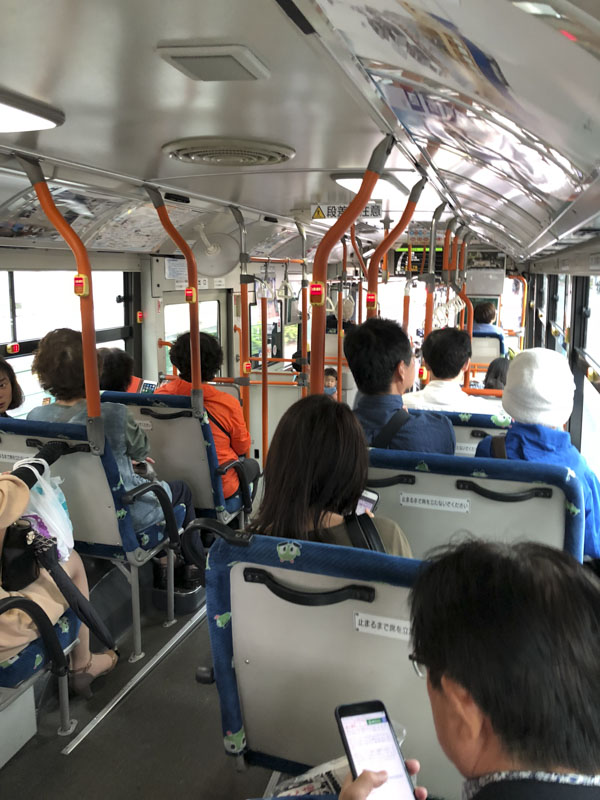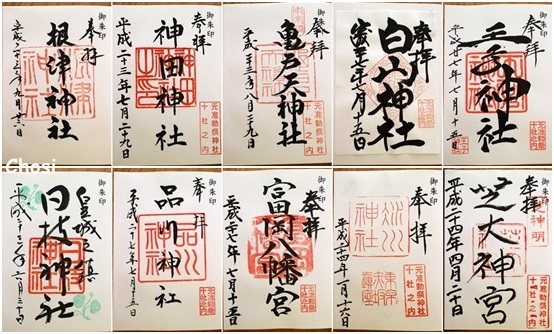Tokyo Jissha, or the ten shrines of Tokyo. These are not the only 10 shrines in Tokyo, nor are they the most important, but they are an integral part of the large network of shrines throughout Tokyo's 23 Wards. The Jissha are built roughly in a ring around the old Edo city center for spiritual protection. There were originally 2 more but due to some historical circumstance, I'll refrain from making speculation on the translations.
The 10 shrines in alphabetical order are: Akasaka Hikawa Jinja 赤坂氷川神社, Hakusan Jinja 白山神社, Hie Jinja 日枝神社, Kameido Tenjin-sha 亀戸天神社, Kanda Jinja 神田神社, Nezu Jinja 根津神社, Oji Jinja 王子神社, Shiba Daijingu 芝大神宮, Shinagawa Jinja 品川神社, and Tomioka Hachiman-gu 富岡八幡宮
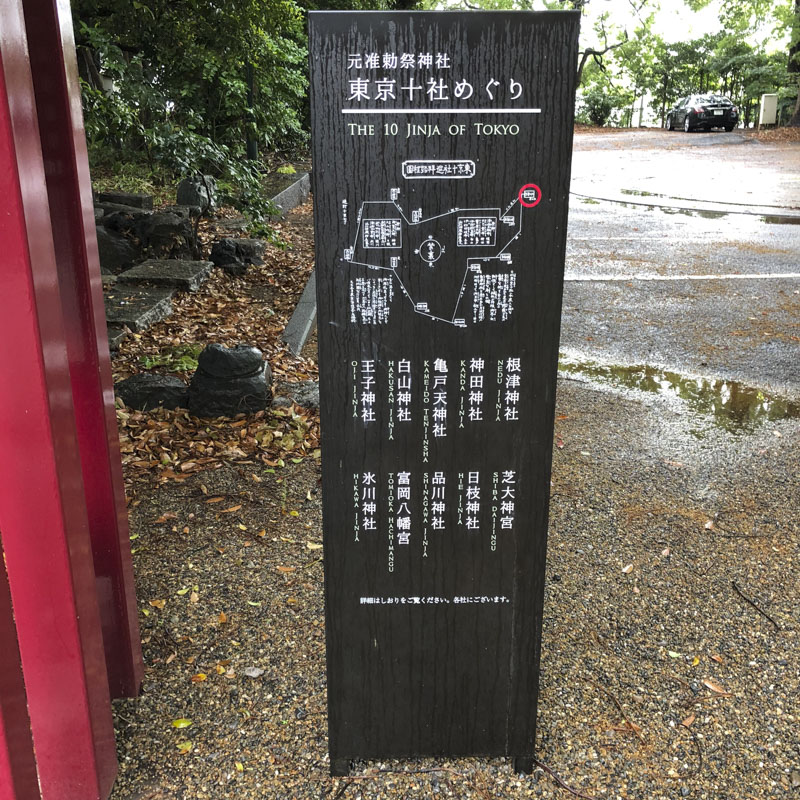
I grouped my visits a bit more casually which gave me plenty of time to make detours and just generally have fun exploring different neighbourhoods throughout some rarely traveled parts of Tokyo. The days below are in order, but perhaps not consecutively. I didn't really plan through this as I had the time and wanted to take a look in a more casual way.
Day 1: Kanda Myojin
My hotel is around Ochanomizu. I often stay in that area because it's in the middle of Tokyo and convenient to go everywhere, but it's out of the way. Most tourists are not here, even though there are quite a few hotels in the area, it's incredibly quiet at night. This means Kanda Myojin shrine is well within walking distance. I've been here during the Kanda festival, in May, which the procession parades around Akihabara and Kanda areas, and i've been here during Obon, with the evening dancing, which is what you're seeing in the video above (although they call it Noryo Matsuri 納涼祭り). The shrine in recent years has some collaboration going on with some anime or manga, but other than a few things on sale with anime characters on them, Kanda Myojin really is only associated with Akihabara culture by proximity.
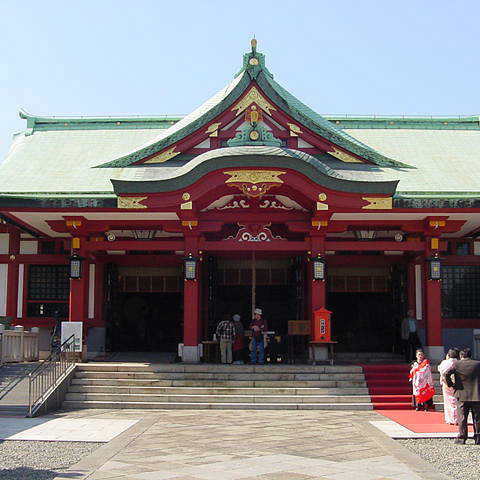

Day 2: Hie & Akasaka Hikawa
Via a quick trip on the subway, I got out of Kokkai-Gijidomae/Tameiki-Sanno station through the Capitol Hotel Tokyu exit. This could easily be done alongside Day 1 as the Marunouchi line at Ochanomizu is only a few minutes walk from Kanda Myojin shrine. Out of the Capitol Hotel Tokyu front entrance, I turned around and went up Sanno-Onnazaka slope to Hie shrine. When I arrived here, it was during the 7-5-3 festival and there were many children here, dressed in their best little black tuxedo suits or little vibrant kimono, having their photos taken by their gushing parents and doting grandparents. I took a few photos, got my goshuin and left through the big staircase out front facing Akasaka's main thoroughfare, Akasaka-dori.
Akasaka-dori is lined on both sides with restaurants and bars, and they're packed tight, with signs pointing into the side streets and up various narrow buildings for more restaurants and more bars. It's a bar hopping paradise, with the Yakiniku, Burger Kings and Chinese gyoza shops to hinder the alcohol's effects enough to drink more. It's packed during the day, I can't imagine how busy it'll be at night. Anyways, turning into one of the side streets past Akasaka Hikawa Park, I came across a Jazz bar called B Flat, maybe something to bookmark for a later date, and a later hour. Anyways, after that, at the corner of Hikawa Budo-jo, is the statue I was aiming to see before reaching the next shrine. This is a statue of Katsu Kaishu and Sakamoto Ryoma, two incredibly interesting historical figures during the Bakumatsu era. Turning here and continuing through some alleyway, is the side entrance to Akasaka Hikawa shrine.
Akasaka Hikawa shrine is a branch of the Hikawa shrine in Omiya, Saitama. Outside of the shrine is a small park with several incredible giant ginkgo trees.
After visiting Hikawa shrine, i continued walking around the area, following the Shutuko overpass, passing the Volkswagen dealership and a big bed and mattress shop, until I got to Roppongi station and ended the day there. For me I went back to do some shopping in Akihabara, but anyone interested in staying around Roppongi can visit Tokyo Midtown for some amazing made-in-front-of-you desserts at Toshi Yoroizuka's patisserie and Roppongi Hills for the observation deck. The view from the observation deck on top of Mori Tower in Roppongi Hills is quite nice during the day, but they have too many reflections to be worthwhile at night, especially when there are alternatives that don't cost anything, like Bunkyo Civic Center near Tokyo Dome, and Tokyo Metropolitan Government Building in Shinjuku. Around Roppongi, there's also the National Art Center and Snoopy Museum.
Alternatively, from Akasaka Hikawa, it's not difficult to walk to Tokyo Tower, then through Zojoji temple, to Shiba-Daijingu and do the reverse of Day 3.
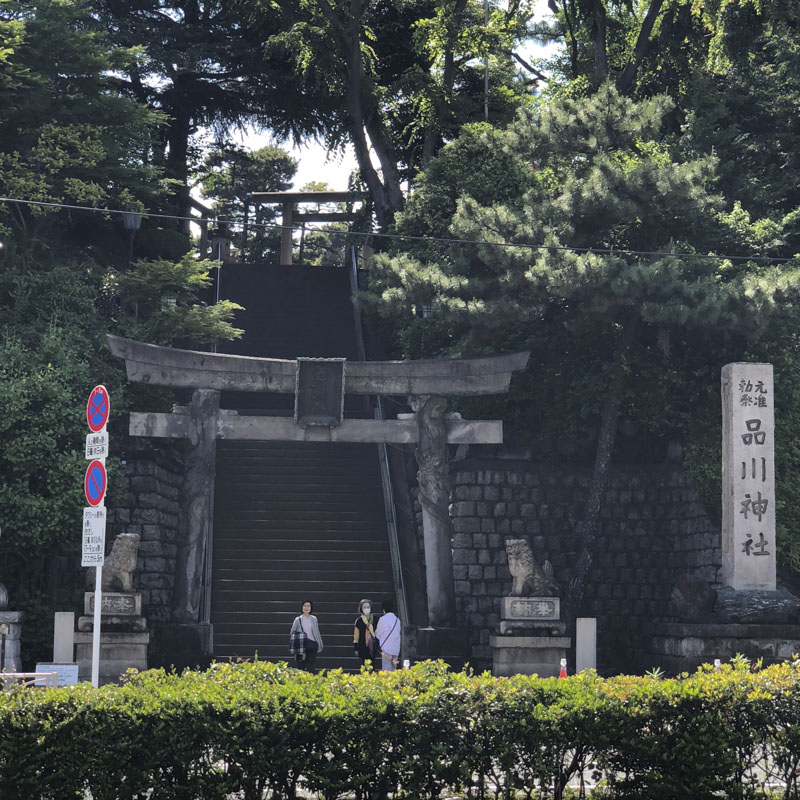
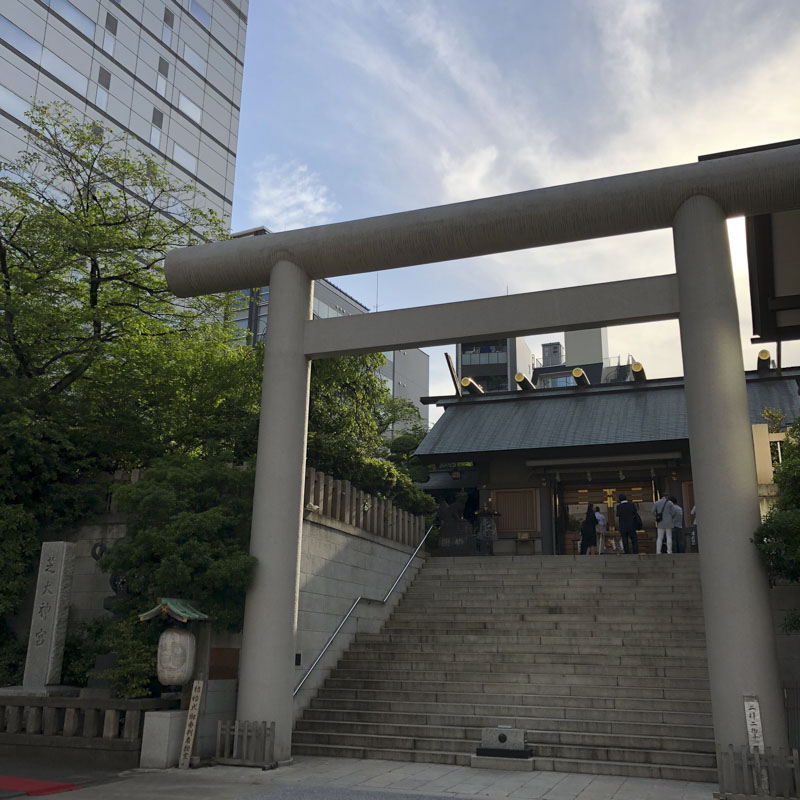
Day 3: Shinagawa & Shiba
This was a fun day visiting an area I really knew very little about, and ultimately ended up somewhere I've been many times before.
I started off getting to Shinagawa, at the time not having completely researched where the shrine is, i then quickly realized it's nowhere near Shinagawa station. So I switch over to the Keikyu line and took that to Shinbanba(alt. Shimbamba) station. The station is right across the street from the nearest street crossing, which so happens there's a Domino's Pizza, something I did not expect to see in Japan. Climbing up the steps it did not take long to take a tour around Shinagawa shrine. Most of the Jissha are not gigantic complexes. I had to climb up twice as I was filming with the Osmo and the gimbal had some problems on the first try. I got my goshuin, walked around a bit then when I was searching for my way to Shiba, I noticed there's another shrine nearby, so I left Shinagawa shrine, when across the street to stop for a quick coffee at Doutor, and continued down that road as it looked interesting.
Apparently this is another one of those old-school Shotengai(shopping street) called Kitabanbasando-dori(北馬場参道通り). It's got some really great old buildings including a several hundreds years old handmade tatami shop called Minatoya Kato(加藤畳店) right next to the entrance of a Shotoku temple. I walked a bit further, crossed the road, crossed a bigger road, through some alley next to a parking lot, and got to a narrow path next to the canal. Walking along the canal gave me so much nostalgia because there were no cars here, no tourists, just a bunch of kids playing by themselves and no parents watching them. Ebara shrine was another small shrine, I paid respects to the Inari shrine next to it, and went looking around for the goshuin place, which ended up being this other little hut to a side that had no one there. It's so quiet here there's a bell to call the goshuin person to come to to the window and stamp your book (from here on I found a few other places like this). After that it was back to Shinbanba station and took the Keikyu line up to Daimon station, with a quick transfer at Shinagawa station.
From Daimon station, I followed Google Map instructions and signage telling me to go out of the A6 exit for Shiba-Daijingu. When I got out of the station, there were signs telling me to go straight then turn right at the next major intersection. This is wrong. I ended up turning in to find out I'm just doing a 180. When you get out of A6 exit, turn right immediately, into the alley right between Risona Bank and this Sarashina soba restaurant. Keep going pass the 7-11 until you get to the next street, turn left and Shiba Daijingu is right there. It's also just as easy getting out of A4 or A5 exits. Anyways, Shiba-Daijingu's main area is quite small but because it does weddings and other ceremonies, it's also annexed an area in a commercial building next door(you'll notice it because there's a permanent red carpet leading out from that building to the front entrance of Shiba Daijingu.... and I was there right when a wedding was going on, and there were a bunch of photographers standing around outside waiting for the bride & groom to finish their Shinto ceremonies inside where photography is not allowed. I walked around the photographers as they're standing right in front of the goshuin counter, got my goshuin, and walked back out towards Zojoji. Which ends the Jissha part of the day.
Zojoji is always such an incredible sight. The front gates are impressive, the grounds have a very grand and elegant feel, but as anyone who's been there can tell you, it's because Tokyo Tower looms in the background. The goshuin counter is inside the smaller Ankokuden building to the right. Got that quickly and took some videos using my Osmo back and forth along the passageway of Jizo statues further right and around to the back of Ankokuden, which so happens to be the mausoleum for the Tokugawa clan. After that I headed to Tokyo Tower. Got there, saw a ton of people, and I left. After this I could head back to the hotel, but I wasn't tired yet and wouldn't mind grabbing a bite to eat so I walked through a park with some beautiful big ginkgo trees, through some alleyways towards Atago Green Hills Mori Tower. I thought there was a route to Seisho temple and got lost in the mess of wooded paths behind the building. That got me to Seisho temple just after 5pm and their goshuin counter was closed for the day. It is a nice temple that I'll come back to visit another time. I then checked Tabelog for nearby recommendations and headed towards Toranomon Hills Mori Tower. There's a casual western restaurant across the street called Good Morning Cafe & Grill. Got some decent pasta but their Shrimp & Mash Ajillo is all kinds of rosemary and garlicky oishii! I haven't had food cooked in a little bubbling pot of hot oil in a long time and this really hit the spot after being in the sun all day. That lovely meal and a refreshing mint tea ended my trip for the day.

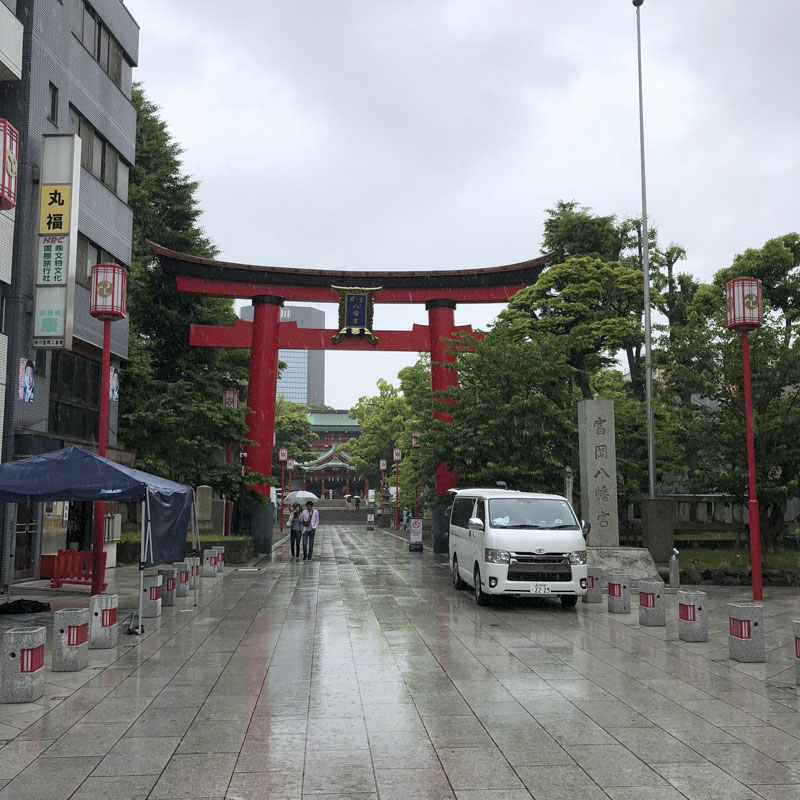
Day 4: Kameido Tenjin & Tomioka Hachiman
This day started off after lunch. I was doing some work online and forgot the time, by the time I realized I was hungry it was already noon. So I grabbed a quick bite and headed off to Kameido Tenjin. It was pretty easy as Ochanomizu is on the Sobu-Chuo line, as are Kinshicho and Kameido stations, both about 8-10 minutes walk from the shrine. I got off at Kinshicho, walked diagonally across the park, crossed the bridge over the canal and reached Kameido Tenjin shrine. I've been to this shrine a number of times before, the previous time was about 2 weeks prior in late April hoping to see some wisteria during the festival, unfortunately, due to early warming weather, the vines were all growing new leaves and wisteria flowers were almost entirely gone, however, the azaleas were blooming nicely which was a pleasant consolation prize, as I also left my goshuincho book back in the hotel. This time, as my eyes were on getting the goshuin, I ignored most of the garden, the festival stalls were all gone, and got my goshuin stamped and left along a side exit, walking towards the canal, which after searching for a convenient way to to to Tomioka Hachiman shrine, i found the path to the bus stop just a straight walk down along the canal, so I was off.
It took about 8 minutes walk to the bus stop, which was at the Chuo-Sobu tracks between the two stations. The [都07] bus arrived quickly and I got on. Google Map tells me I'm going from Kameido 1-chome bus stop to Tomioka 1-chome bus stop and ¥210, I smacked the machine with my Suica and found a seat at the back, pretty simple. 16 stops and 20 minutes later I was across the street from Tomioka Hachimangu shrine. Half way there it started raining and by the time the bus stopped it was a heavy downpour. Luckily after getting a little wet crossing the street, there was a Family Mart and I bought one of those transparent wind resistant umbrella. So passing the big torii and cleansed my hands I was at Tomioka Hachimangu. The goshuin counter is to the right of the main shrine. I got my goshuin and walked through that tunnel under the building to the back. There's a narrow side passage to the Inari shrine where I paid respects and took a quick look around the other 2 minor shrines there. Then I walked back through the narrow passage, pass the Yokozuna tribute and the shrine's parking lot to the back road. I was surprised when Google Map pointed out there was a fairly big temple if I turn left onto that back road and just walked straight for a few minutes so I did, and there it was.
Fukagawa Fudodo was right there, and it was pretty impressive, not that it was a huge temple, but the front had a few high walls covered in Sanskrit, and I like the architecture of temples dedicated to Fudo-myo-o, they're always a bit dark and mysterious, like the Asian equivalent of Gothic architecture. The goshuin counter was across the outdoor square at what looks like some temporary stalls, and as I gave them my book, they gave me a numbered tag and said 20 minutes, please visit the temple and come back, so I complied. Apparently the inside areas are not very brightly lit either as I was there right when they're doing their public prayers. I quickly took off my shoes, put it and my umbrella in a recycled plastic bag and sat down. BOOM! Damn those drums are loud. While I may not be very religious, I do enjoy listening to Buddhist chants(as much as I do Gregorian chants). It's very musical. My mind wandered off for about 15-20 minutes, after which, I explored the rest of the temple which didn't take very long, and left. The goshuin was ready, I picked it up and left by the side entrance where I came in from. Turning left onto the road right outside, will lead me towards Kiyosumi-Shirakawa and to my final destination of the day, Blue Bottle Coffee. It wasn't a long walk, crossed another canal, and I was already there. The area looks to be mainly residential but there's also quite a few repurposed old warehouses. After a really nice cuppa joe, I continued up, past a big cemetery, past what looks like a nice brioche con gelato shop(aka ice cream sandwich) called Brigela(bookmarked for a later visit), towards Kiyosumi-Shirakawa station.
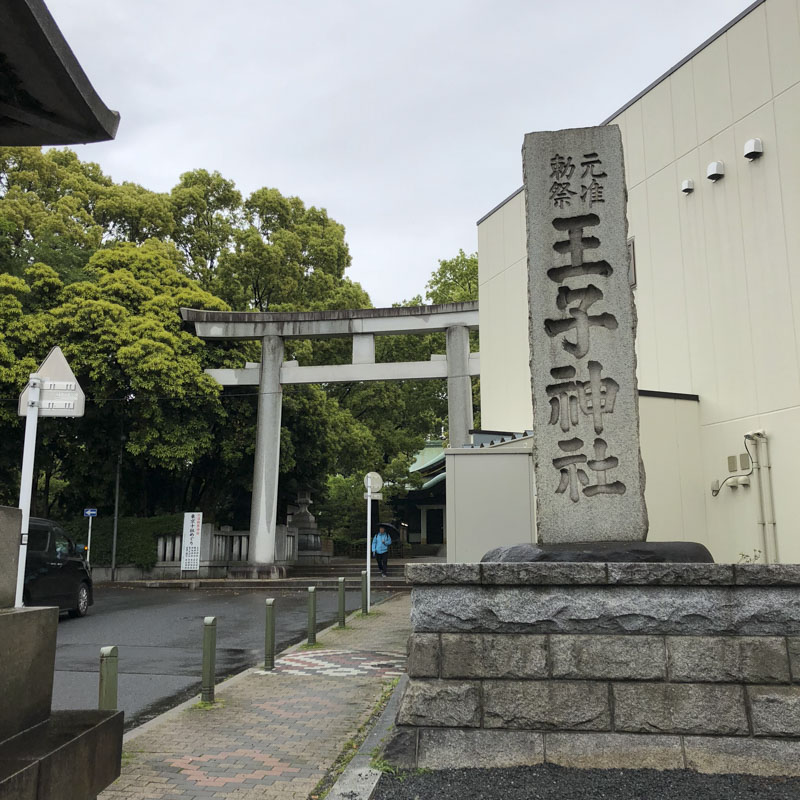

Day 5: Oji, Hakusan, & Nezu
I had this day planned somewhat, as it's in a rough line, I chose to take the train to the furthest point then work my way back.
So I got on the Keihin Tohoku line from Akihabara station straight to Oji. Oji's a weird place full of hills. I must go back and explore it further when I get a chance. I must admit, I got so confused by this simple station's layout. I got out at the nearest exit, which turned out to be wrong, it lead into a park, and Google Map showed a confusing web of paths none of which led me towards the shrine. So I headed for the north exit, which led me to one of the entrances to the same park, and a strange little mini hill-climbing monorail, which wasn't open yet. So I trodded up along the sidewalk hoping to find a way to cross the street. Apparently I was wrong again as there's no crossing until much further the wrong way from the shrine. I felt a bit defeated heading back to the station again, finding a pedestrian overpass and climbed it, feeling like the chicken in the age-old joke, "Why did the chicken cross the road? To get to the other side." After which, I thought I was at Todoroki Ravine as there was a small river beneath me. Apparently it's called Otonashi Water Park. Don't think western concepts of what a water park is, there's no water slides here. This is just a very pretty flood diversion canal, and even more pretty during sakura season. Anyways, further down and up some stairs, Oji shrine is before me.
The white pillars in front makes it look very regal, and the roof tiles are done beautifully. Goshuin done, I left, with a reminder to myself to come back again as there's so much more to see around this hilly area. There's an Inari shrine somewhere close by I need to visit, as well as a Banknote & Postage Stamp Museum, and a Paper Museum, and that strange little monorail leading up to Asukayama Park, which is another great spot for sakura viewing. Back to Oji station, this time on the Namboku line, it's a short ride to Hon-komagome Station, and a brisk walk to Hakusan shrine. Nothing much out of the ordinary here, Hakusan is a pretty normal residential area. There's a few zakka shops I may want to return to when I have more time, but that's about it. From this direction, I got to Hakusan by it's side entrance. There's a few bushes of blooming pretty flowers, but it's far too early for the Bunkyo Ajisai(Hydrangea) festival, which should be around mid June.
After getting the goshuin at Hakusan, I started my way towards Nezu. Along the main road Hongo-dori, I walked by a laughing buddha statue. It wasn't very big but it was really tacky and orange. The thing looked like it was made with papier-mache. I almost considered walking by but decided to go in to this Jyoshinji and look for a goshuin here. I did a double take, the temple and the temple grounds are actually quite nice, albeit quite small and really packed with tombstones. This is another spot when I had to bother someone to get the goshuin, but it's a little tricky. I kept looking for a bell at a window but couldn't find one anywhere. The only door that seem to be in use had someone's last name on it, which I thought was the temple caretaker's home. I wandered around for 10 minutes looking around before I decided to disturb them because I saw a sign saying it's ok to bother them after 1pm, which seemed weird. So I rang the bell and a kind lady answered saying this is the spot for goshuin. I paid the 300yen and as expected, she handed me a package. The goshuin page is inside and I had to stick it on my book with glue. Yes, some places are like this. The person writing these aren't always there so they sometimes have these pre-made so visitors don't need to leave empty-handed. The package also included a leaflet with upcoming events which are more for neighbourhood Buddhists. I thanked her and continued onwards to Nezu shrine.
A few more minutes and I arrived at Nezu's back entrance. This is where the Inari shrine begins, and the torii tunnel leads towards the front entrance where the spherical shaped Azalea bushes are. Azalea bloom has been over for about a week, so I just went inside the Nezu shrine area for goshuin, which is at the right side of the main shrine building. I've been to Nezu shrine several times before taking different friends here to show them the height-challenged torii tunnel (most of the torii there have lower beams at my eye level, and I've banged my head on them on more than one occasion). After getting the goshuin, I left through the front gates and out onto Shinobazu-dori and left via Nezu station.
From Nezu station, if I was to continue on along the back road between Tokyo University and Ueno Park, I'd reach the Kyu-Iwasaki-tei Gardens, which was the original estate of the founder of Mitsubishi industries. Behind it next to the back entrance to Tokyo University, would be the National Archives of Modern Architecture. Then further down next to Yushima station, is Yushima Tenmangu shrine. From here, head east to the next major intersection and you'll be in the middle of Ueno.
That's it, took me 5 days to cover 10 shrines when there's plenty of people who did this in a single day, but like I said before, I was not in a hurry and exploration is fun. I found a lot of new places to revisit. Over 40 years of visiting Japan, and the most visited city of Tokyo can still surprise me.
(side note: yes, I've visited several Buddhist temples while doing this Shinto shrine run. I have separate goshuin books to respect the two different religions.)
